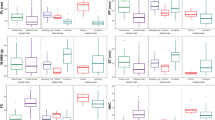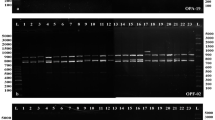Abstract
Diversity among 36 snapmelon landraces, collected from 2 agro-ecological regions of India (9 agro-climatic sub-regions), was assayed using RAPD primers, morphological traits of plant habit and fruit, 2 yield-associated traits, pest and disease resistance and biochemical composition (TSS, ascorbic acid, titrable acidity). Typical differences among accessions were observed in plant and fruit characteristics and snapmelon germplasm with high titrable acidity and possessing resistance to downy mildew, Cucumber mosaic virus, Zucchini yellow mosaic virus, Papaya ringspot virus, Aphis gossypii and Meloidogyne incognita was noticed in the collection. RAPD based grouping analysis revealed that Indian snapmelon was rich in genetic variation and region and sub-region approach should be followed across India for acquisition of additional melon landraces. Accessions of var. agrestis and var. momordica clustered together and there was a separate cluster of the accessions of var. reticulatus. Comparative analysis of the genetic variability among Indian snapmelons and an array of previously characterized reference accessions of melon from Spain, Israel, Korea, Japan, Maldives, Iraq, Pakistan and India using SSRs showed that Indian snapmelon germplasm contained a high degree of unique genetic variability which was needed to be preserved to broaden the genetic base of melon germplasm available with the scientific community.




Similar content being viewed by others
References
Akashi Y, Fukuda N, Wako T, Masuda M, Kato K (2002) Genetic variation and phylogenetic relationships in East and South Asian melons, Cucumis melo L., based on the analysis of five isozymes. Euphytica 125:385–396
Bajaj LK, Kaur G (1981) Spectrophotometric determination of l-ascorbic acid in vegetables and fruits. Analyst 106:117–120
Baudracco-Arnas S, Pitrat M (1996) A genetic map of melon (Cucumis melo L.) with RFLP, RAPD, isozyme, disease resistance and morphological markers. Theor Appl Genet 93:57–64
Burger Y, Sa’ar U, Distelfeld A, Katzir N (2003) Development of sweet melon (Cucumis melo) genotypes combining high sucrose and organic acid content. J Amer Soc Hort Sci 128:537–540
Cohen Y, Meron I, Mor N, Zurial S (2003) A new pathotype of Pseudoperonospora cubensis causing downy mildew in cucurbits in Israel. Phytoparasitica 31:452–466
Danin-Poleg Y, Paris HS, Cohen S, Rabinowitch HD, Karchi Z (1997) Oligogenic inheritance of resistance to zucchini yellow mosaic virus in melons. Euphytica 93:331–337
Danin-Poleg Y, Reis N, Tzuri G, Katzir N (2001) Development and characterization of microsatellite markers in Cucumis. Theor Appl Genet 102:61–72
Dogimont C, Lecomte L, Perin C, Thabuis A, Lecoq H, Pitrat M (2000) Identification of QTLs contributing to resistance to different strains of cucumber mosaic cucumovirus in melon. Acta Hort 510:391–398
Doyle JJ, Doyle JL (1990) Isolation of DNA from fresh tissue. Focus 12:13–15
Duthie JF (1905) Flora of the Upper Gangetic Plain and the adjacent Sivalik and sub-Himalyan tracts. Vol 1. Ranunculaceae to Companulaceae. Office of the Supereintendent of Government Printing, Calcutta
Garcia-Mas AJ, Oliver M, Gomez-Paniagua H, DeVicente MC (2000) Comparing AFLP, RAPD and RFLP markers for measuring genetic diversity in melon. Theor Appl Genet 101:860–864
Ghosh SP (1991) Agroclimatic zones specific research–Indian Perespective under NARP. ICAR, Pusa, New Delhi, India
Gonzalo MJ, Oliver M, Garcia-Mas J, Monfort A, Dolcet-Sanjuan R, Katzir N, Arus P, Monforte AJ (2005) Development of a consensus map of melon (Cucumis melo L.) based on high-quality markers (AFLPs and SSRs) using F2 and double-haploid line populations. Theor Appl Genet 110:802–811
Gur A, Zamir D (2004) Unused natural variation can lift yield barriers in plant breeding. PloS Biol 2:1610–1615
Harwood RR, Markarian D (1968) A genetic survey of resistance to powdery mildew in muskmelon. Heredity 59:213–217
Jeffrey C (1980) A review of the Cucurbitaceae. Bot J Linn Soc 81:233–247
Jeffrey C (2001) Cucurbitaceae. In: Hanelt P and Institute of Plant Genetics and Crop Plant Research (eds), Mansfeld’s encyclopedia of agricultural and horticultural crops. Berlin: Springer, pp 1510–1557
Kishaba AN, Bohn GW, Toba HH (1971) Resistance to Aphis gossypii in muskmelon. J Econ Entom 64:935–937
Lal T, Dhiman JS, Dhaliwal MS (1994) Evaluation of snapmelon genotypes for downy mildew resistance. Adv Hort Sci 8:153–155
Lecoq H, Cohen S, Pitrat M, Labonne G (1979). Resistance to cucumber mosaic virus transmission by aphids in Cucumis melo. Phytopathology 69:1223–1225
Lopez-Sese A, Staub JE, Gomez-Guillamon ML (2003) Genetic analysis of Spanish melon (Cucumis melo L.) germplasm using a standardized molecular marker array and reference accessions. Theor Appl Genet 108:41–52
McCreight JD, Staub JE, Lopez-Sese AI, Chung SM (2004) Isozyme variation in Indian and Chinese melon (Cucumis melo L.) germplasm collections. J Amer Soc Hort Sci 129:811–818
Monforte AJ, Garcia-Mas J, Arus P (2003) Genetic variability in melon based on microsatellite variation. Plant Breed 122:153–157
Monforte AJ, Eduardo I, Arus P (2005) Inheritance mode of fruit traits in melon-heterosis for fruit shape and its correlation with genetic distance. Euphytica 144:31–38
More TA (2002) Enhancement of muskmelon resistance to disease via breeding and transformation. Acta Hort 588:205–211
Morii S, Fujishita N, Momodani Y (1980) Phylogenetic analysis in C. melo based on isozyme polymorphism, with special reference to the relationship between weed melon and cultivated melon. J Japan Soc Hort Sci 49:188–189 (Japanese)
Neuhausen SL (1992) Evaluation of restriction fragment length polymorphism in Cucumis melo. Theor Appl Genet 83:379–384
Pan RS, More TA (1996) Screening of melon (Cucumis melo L.) germplasm for multiple disease resistance. Euphytica 88:125–128
Pitrat M, Lecoq H (1984) Inheritance of Zucchini Yellow Mosaic Virus resistance in Cucumis melo L. Euphytica 33:57–61
Pitrat M, Hanelt P, Hammer K (2000) Some comments on infraspecific classification of cultivars of melon. Acta Hort 510:29–36
Schaffer A, Petreikov M, Miron D, Fogelman M, Spiegelman M, Bnei-Moshe Z, Shan S, Granot D, Hadas R, Dai N, Levine I, Bar M, Friedman M, Pilowsky M, Gilboa N, Chen L (1999) Modification of carbohydrate content in developing tomato fruit. HortScience 34:12–15
Sehgal JL, Mandal DK, Mandal C, Vadivelu S (1992) Agro ecological regions of India. National Bureau of Soil Survey and Land Use Planning (ICAR), Nagpur, India
Silberstein L, Kovalski I, Huang R, Anagnostou K, Jahn M, Perl-Treves R (1999) Molecular variation in melon (Cucumis melo L.) as revealed by RFLP and RAPD markers. Sci Hort 79:101–111
Singh PP, Thind TS, Lal T (1996) Reaction of some muskmelon genotypes against Pseudoperonospora cubensis under field and artificial epiphytotic conditions. Indian Phytopathol 49:188–190
Sorria C, Diaz JA, Moriones E, Gomez-Guillamon ML (2000) Resistance to Aphis gossypii and to virus transmission by this aphid in melon. In: Katzir N, Paris HS (eds) Proceedings Cucurbitaceae 2000. Acta Hortic. (ISHS 2000), 510, 305–312
Staub JE, Lopez-Sese AI, Fanourakis N (2004) Diversity among melon landraces (Cucumis melo L.) from Greece and their genetic relationships with other melon germplasm of diverse origins. Euphytica 136:151–166
Stepansky A, Kovalski I, Perl-Treves R (1999a) Intraspecific classification of melons (Cucumis melo L.) in view of their phenotypic and molecular variation. Plant Syst Evol 217:313–332
Stepansky A, Kovalski I, Schaffer AA, Perl-Treves R (1999b) Variation in sugar levels and invertase activity in mature fruit representing a broad spectrum of Cucumis melo genotypes. Genet Resour Crop Evol 46:53–62
Swarup V (2000) Genetic resources in vegetable crops in India. In: Kallo G, Singh K (eds) Emerging scenario in vegetable research and development. Research Periodicals and Book Publishing Home, India, pp 346–355
Tanksley SD, McCouch SR (1997). Seed banks and molecular maps: unlocking genetic potential from the wild. Science 277:1063–1066
Thomas CF, Cohen Y, McCreight JD, Jourdain EL, Cohen S (1988) Inheritance of resistance to downy mildew in Cucumis melo. Plant Dis 72:33–35
Wang YH, Thomas CE, Dean RA (1997) A genetic map of melon (Cucumis melo L.) based on amplified fragment length polymorphism (AFLP) markers. Theor Appl Genet 95:791–798
Williams JGK, Kubelik AR, Livak KJ, Rafalski J, Tingey SV (1990) DNA polymorphism amplified by arbitrary primers are useful as genetic markers. Nucl Acid Res 18:6531–6535
Yamaguchi M, Hughes DL, Yabumoto K, Jennings WC (1977) Quality of cantaloupes: variability and attributes. Sci Hort 6:59–70
Yoshida Y, Kohyma T (1986) Mechanisms, genetics and selection methods of aphid resistance in melons, Cucumis melo. Bull Veg Ornam Crops Res Station 9:1–12
Acknowledgements
Ranjana was supported by a Junior Research Fellowship of Indian Council of Agricultural Research. The authors thank Professor G. J. Jellis for helpful comments and F. García for technical assistance. We are grateful to Prof. Karl Hammer and Dr. Klaus Pistrick for providing valuable comments. This work was funded in part by grants AGL2003–09175-C02–01 (to AJM) from the Spanish Ministry of Education and Science. AJM was partly supported by a contract from Instituto Nacional de Investigación y Tecnología Agraria y Alimentaria (INIA), Spain. IE was supported by a fellowship from the Spanish Ministry of Education.
Author information
Authors and Affiliations
Corresponding author
Additional information
N. P. S. Dhillon and Ranjana contributed equally to this work and are considered the first authors.
Rights and permissions
About this article
Cite this article
Dhillon, N.P.S., Ranjana, ., Singh, K. et al. Diversity among landraces of Indian snapmelon (Cucumis melo var. momordica). Genet Resour Crop Evol 54, 1267–1283 (2007). https://doi.org/10.1007/s10722-006-9108-2
Received:
Accepted:
Published:
Issue Date:
DOI: https://doi.org/10.1007/s10722-006-9108-2




